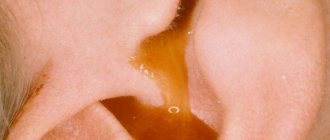Causes
The causative agents of the disease can be viruses, bacteria, and even fungi. But in most cases, purulent throat lesions develop due to the proliferation of bacteria of the genus streptococcus. Moreover, in children such inflammation is often primary. And in adults it usually happens due to complications caused by severe respiratory diseases.
Bacteria of the genus Streptococcus
Pathogenic agents penetrate the tonsils exogenously or endogenously. In the first case, infection occurs through contact with a sick person. That is, purulent tonsillitis is contagious. In the second - with various infectious processes in the body that “spread” to the tonsils.
Therefore, it is not so easy to answer the question of how purulent tonsillitis is transmitted. Many pathogens are constantly present in the mouth and throat. But they do not affect a person’s well-being. And only with a weakened immune system are they activated. And this leads to inflammation of the tonsils.
Purulent tonsillitis in children and adults develops under the following conditions:
- hypothermia of the throat or the body as a whole;
- activation of other infections in the body;
- damage to the tissues of the tonsils, for example, their burn;
- severe environmental pollution;
- excessively high percentage of humidity in the room;
- changing climatic conditions;
- as a result of food poisoning or exposure to solar radiation;
- poor nutrition;
- bad habits;
- constant fatigue and stress;
- decreased immunity of various etiologies.
The incubation period of purulent sore throat is short - usually no more than 2-3 days.
How to treat pus on the tonsils with and without fever
How to treat pus on the tonsils is determined by the attending physician after examination. Various rinses are used as first aid at home.
Home treatment is also acceptable if a person knows exactly his diagnosis, for example, with chronic tonsillitis.
Drug treatment
Very good for mouth and throat infections
In case of acute tonsillitis with fever:
- antiseptic mouth rinses;
- antipyretics and painkillers to relieve acute symptoms;
- antibiotics - strictly as prescribed by the doctor.
For gargling, solutions of Chlorophyllipt, Chlorhexidine, Miramistin, Furacilin, and Lugol's preparation are used. The doctor will give recommendations on the preparation of the solution and the frequency of gargling. As a rule, otolaryngologists recommend gargling for sore throat 4 times a day. Additionally, sprays (Inhalipt, Givalex, Agisept) or lozenges to relieve sore throat (Strepsils, Neo-angin, Septolete) may be prescribed.
“Temperature” intoxication is accompanied by a symptom such as pus on the tonsils with a high temperature, characteristic of acute tonsillitis. In this case, drinking plenty of fluids is additionally recommended.
READ ALSO: Cold pimples on the face - treatment, on the body, nose, causes, photos
How to treat pus on the tonsils without fever - it depends on the reason for its appearance. For chronic tonsillitis, antiseptic rinsing solutions, professional rinsing of lacunae and immunostimulants are used; for candidiasis, rinses based on iodine or chlorhexidine and antimycotics in tablets are used.
Cleaning tonsils from purulent plugs
For chronic tonsillitis, professional cleaning is indicated, which will help both remove pus from the tonsils and cure a sluggish inflammatory process. The procedure is performed in a doctor's office. For this, a syringe or vacuum device is used.
The doctor inserts the tip of a device or syringe into the lacunae and breaks the plugs, while simultaneously irrigating the lacunae with an antiseptic solution. A course of such procedures is indicated for the treatment of chronic tonsillitis.
At home, cleaning is carried out using a syringe with a curved tube at the end, or an irrigator. Furacilin solution is poured into the device (1 tablet per glass of water), the tip is brought close to the lacuna, then the antiseptic is injected into the depressions in the tonsils, washing out the purulent contents.
At home, pus on the tonsils is removed carefully so as not to damage the tonsil tissue, so the tip of the syringe or irrigator is not inserted into the lacuna, but is placed opposite the recess of the tonsil. The purulent contents are removed from the lacunae under the influence of a stream of antiseptic solution.
Treatment with folk and home remedies
Brewed field chamomile flowers effectively cope with diseases of the tonsils
Treatment of pus on the tonsils without fever is carried out by rinsing the mouth. At home, for this purpose they use:
- sea salt solution (1 teaspoon per glass of water);
- baking soda solution (1 teaspoon per glass of water);
- iodine solution (3-5 drops per 200 ml of water);
- decoction of calendula, sage, chamomile or oak bark;
- propolis tincture.
To prepare the decoction, you need to take 2 large spoons of the selected medicinal plant, add two glasses of water and cook for 15 minutes under the lid over low heat. Then cool the product, strain and use to rinse the mouth.
For chronic inflammation, without fever, it is useful to treat the tonsils with propolis tincture. You can purchase it at any pharmacy at an affordable price. The product is diluted with water at the rate of 1 tablespoon per glass of water and used to rinse the mouth.
READ ALSO: Lipoma - what is it and how to treat it? Symptoms and treatment
After the pus on the tonsils is removed, treatment of tonsillitis is supplemented with immunostimulants. The most effective folk remedy is echinacea tincture. It should be taken for two weeks, 15 drops three times a day.
What to do if pus on the tonsils is accompanied by fever:
- gargle with sea salt;
- lubricate the tonsils with Lugol's solution;
- bring down the temperature with a vodka or vinegar compress.
The throat should be gargled every 4 hours. If the fever does not go away after 2-3 days, you should stop self-medication and consult a doctor.
Physiotherapy
Since pus on the tonsils without fever in the vast majority of cases is a sign of chronic tonsillitis, complex treatment is necessary. The following physiotherapy methods are often used:
- warming up on the “Solnyshko” apparatus (ultraviolet irradiation of the tonsils);
- exposure to infrared rays;
- mud applications on the throat.
These methods improve metabolic processes and increase local immunity, therefore they are used in addition to drug therapy for chronic tonsillitis.
https://youtu.be/https://www.youtube.com/watch?v=ayUrU4uFWZg
_
Types of disease
There are the following types of acute tonsillitis, which occurs with the formation of pus.
- Purulent follicular tonsillitis. The formation of many foci under the mucous membrane of the tonsils is characteristic - in the follicles.
- Lacunar tonsillitis. Purulent contents fill the lacunae of the tonsils.
- Purulent-necrotic tonsillitis. Appears as a result of complications of the two previous types of inflammation. It is characterized by the death of the mucous membrane and deep tissues of the tonsils, as well as the structures adjacent to them.
- Phlegmonous, or paratonsillar abscess. This is an extremely severe inflammation of one of the tonsils. It also often occurs as a complication.
Necrotizing tonsillitis and peritonsillar abscess are rare diseases. Therefore, in most cases, when people want to know how to treat purulent tonsillitis, they mean the lacunar or follicular form of the disease.
Pustules in the throat: causes of formation
The most common causes of sore throat are:
1
Gangrenous-necrotic, follicular, lacunar or catarrhal tonsillitis, pharyngitis. The disease is most often caused by bacteria such as streptococcus pyogenes, fecal or Staphylococcus aureus, and Pseudomonas aeruginosa.
In addition to the formation of pus balls in the throat, the pathology occurs with intoxication and characteristic changes in the peripheral blood.
2
Adenovirus infection is a separate form of acute respiratory viral infection, characterized by damage to lymphoid tissue in the oropharynx.
With this disease, the throat is covered with white coatings, high fever, nasal congestion and follicular conjunctivitis are observed.
3
Infectious mononucleosis is a systemic pathology of herpes viral nature with damage to the reticuloendothelial system (tonsils, spleen and lymph nodes).
During the examination, hypertrophied palatine tonsils covered with a dirty gray coating, enlarged peripheral lymph nodes and the spleen are discovered; characterized by undulating fever.
4
Herpangina is an acute infection of a viral nature. In case of infection, white pustules, vesicles and ulcers appear on the tonsils.
Aphthous stomatitis and pharyngomycosis caused by fungi or associated flora have a similar clinical picture.
5
Chronic tonsillitis, paratonsillar abscess. In the first case, the damage to the palatine tonsils has a chronically recurrent course, in the second, a severe complication of acute tonsillitis develops in the form of encysted purulent inflammation in the peripharyngeal tissue.
6
Diphtheria is a dangerous infection, which today has been minimized through preventive immunization.
The disease is based on the action of diphtheria bacillus toxins and the development of fibrinous inflammation.
Single plaques on the mucous membrane of the oropharynx can also appear as a result of injury or burn.
Clinical picture
Nature of tonsil damage
The main symptom is the presence of purulent formations on the tonsils. The appearance of ulcers depends on the form of inflammation:
- follicular is characterized by clearly defined small lesions that may be visible as white dots or may have a yellowish tint;
- lacunar - shows large purulent foci of irregular shape.
The difference between one form and another can be clearly seen in the photo.
The classic signs of purulent tonsillitis in the tonsil area are as follows.
- Inflammation occurs exclusively on the tonsils. There are no signs of damage to the back of the throat, uvula or palate.
- Presence of pus on both sides of the throat. This is the main feature of purulent tonsillitis, which can be called “ordinary” (lacunar, follicular). If an abscess forms, it is visible only on one side. True, it may be that a patient develops ulcers on different tonsils that are slightly different from each other. This is a normal situation. Sometimes it indicates that a follicular lesion is developing on one side and a lacunar lesion on the other.
- Inflammatory formations disappear after 5 days. In the first days they burst and pus flows out. Then the wound heals. If pus remains on the tonsils for more than 10 days after completing the course of treatment, then this is due to some other disease. Chronic purulent tonsillitis does not exist, because tonsillitis is always an acute inflammation. And nothing else.
General symptoms
Symptoms of general malaise are:
- sore throat and redness;
- heat;
- general deterioration of condition;
- discomfort in muscles and joints;
- headache (severe purulent tonsillitis in children can even occur with loss of consciousness);
- inflammation of the lymph nodes, which become painful.
At the same time, true sore throat with pus is never accompanied by symptoms such as cough and rhinitis.
Another distinctive feature is the temperature during purulent sore throat, which reaches 40°C. Children always have hyperthermia. In adults, the temperature may remain within the subfebrile range. But that rarely happens. Purulent sore throat without fever is an exception to the rule.
During the acute phase of the disease, the patient feels a loss of strength, pain in muscles and joints, headache, etc. All these sensations can be so strong that a person cannot get out of bed. In addition, there is a digestive upset: nausea, vomiting and diarrhea. These signs are especially pronounced in children.
The acute period lasts up to 5 days. Then it becomes much easier. But throughout the entire period of treatment, the patient requires bed rest.
Pain syndrome
The disease is characterized by a constant sore throat. As a rule, she is strong. And only sometimes it is moderate. If your throat doesn't hurt, it's some other disease.
In the early stages of the disease (12 hours after the onset of symptoms), the patient does not feel acute pain. At first it might just be sore. But gradually the pain when swallowing intensifies and becomes constant.
At the main stage of the disease, the pain in the throat is so severe that it can no longer be tolerated. The patient has to stop drinking food and water. The pain radiates to the ear, which gives the patient the impression of otitis media.
With purulent tonsillitis, pain does not extend below the Adam's apple. The entire inflammatory process is concentrated in the tonsils. If the pain is localized in the Adam's apple or near the collarbone, then this is laryngitis or tracheitis.
The patient experiences pain for a week. But already on the third day the patient refuses local drug treatment of the throat, as the pain subsides so much that he can freely eat and drink.
Symptoms
Stomatitis as a consequence of advanced dental disease
Pus on the tonsils and throat is a symptom of four diseases at once:
- tonsillitis;
- pharyngitis;
- oral candidiasis;
- stomatitis.
Each disease has its own symptoms.
Tonsillitis, or sore throat, can be acute or chronic. In acute tonsillitis, there is pus on the tonsils with fever, symptoms of intoxication, severe pain in the throat when swallowing. The temperature may rise above 38 degrees.
The following symptoms are characteristic of chronic tonsillitis:
- light dots and spots in gaps (plugs);
- general malaise;
- bad breath;
- general weakening of the body;
- enlargement of the mandibular lymph nodes.
With pharyngitis, plaque is observed on the tonsils and nasopharynx. The throat is inflamed, irritated, feels dry and scratchy. Pain when swallowing is also present, but there is almost never a high temperature; it rises to an average of 37.5 degrees.
READ ALSO: Facial care after 30-35 years at home, oily, dry, problem skin, advice from a cosmetologist, procedures, folk remedies, creams, masks, massage
With stomatitis and candidiasis, body temperature does not increase. These diseases are associated with infection of the oral mucosa. Oral candidiasis is a fungal disease that affects children. It is very simple to distinguish it from other forms of the disease - the plaque is easily cleaned off with a cotton swab, but after 1-2 hours it appears again.
Stomatitis is an inflammatory disease of the oral mucosa. Symptoms are the formation of wounds and ulcers on the mucous membranes of the cheeks and throat. The cause of stomatitis is often advanced caries.
Making a diagnosis
As a rule, the diagnosis is made simply on the basis of the general picture of the disease. Therefore, it is necessary to carefully monitor symptoms.
The disease is not characterized by cough and rhinitis. These symptoms are an indicator of the presence of another disease, often viral in nature, such as influenza.
There are other signs to be aware of.
- The appearance of purulent formations outside the tonsils occurs with other infectious diseases, for example, diphtheria, mononucleosis.
- The back wall of the throat remains clean, there are no deposits or plaque on it, which can appear due to viral or fungal infections.
- When purulent formations open, bleeding does not begin.
- There are no skin manifestations (rash, redness).
- The presence of purulent discharge and foci of inflammation after the end of treatment indicates chronic tonsillitis.
- With classic purulent tonsillitis, inflammation of one tonsil does not occur. The lesion is bilateral.
Correct differential diagnosis requires not only examination of the patient, but also laboratory tests.
A bacterial swab is taken from the throat. His analysis shows the presence of streptococci and staphylococci.
The following should be detected in the blood:
- an increase in neutrophil rods - a slight change in the leukogram;
- increase in the number of neutrophils;
- ESR is above 30 mm/h.
Additional research is also being conducted:
- ECG - to check the functioning of the heart;
- antibiogram – to choose a method of treating the disease;
- Ultrasound of the abdominal cavity (prescribed for pregnant women);
- X-ray of joints.
How to get rid of ulcers in the throat at home
It is important to keep in mind that folk remedies are used exclusively as an auxiliary therapy. It is not possible to cure a sore throat with ulcers with their help. Only mild lesions of the mucous membrane, not associated with a bacterial or fungal process, can be treated at home.
For chronic tonsillitis, which occurs without fever or inflammation, you can rinse with a decoction of sage, eucalyptus, mint, chamomile, and oak bark. Inhalations from the same herbs are very effective in treating children (in the absence of high fever).
Products that can be found in every home can relieve painful sensations - beets, honey, garlic, lemon. You can gargle with a decoction of purified and boiled beets in 2 liters of water. Honey in its pure form should be eaten regularly - it strengthens the immune system and supports the body in the fight against infection. A decoction made from crushed and infused in boiling water (300 ml) of a couple of cloves of garlic can be used to gargle for 5 days.
It should be remembered that only complex therapy can quickly and effectively cure purulent throat diseases.
Treatment
To quickly successfully get rid of the disease, it is important to know not only how to treat purulent tonsillitis with medication, but also what general rules should be followed.
The patient is recommended to rest in bed. Failure to follow this rule may lead to complications.
Plenty of warm drinks (herbal and regular teas, fruit drinks and jelly) are recommended.
It is recommended to adhere to a special diet: eat light foods enriched with vitamins. You should exclude solid foods and give preference to liquid, low-fat, sometimes ground warm foods. Cold and hot foods and foods with spices can cause irritation.
It is recommended to use the following products:
- fermented milk and dishes made from them, eggs, vegetable purees;
- chicken, fish and meat broths;
- freshly squeezed juices, jelly, compotes, tea with lemon and honey, herbal teas;
- bananas and fruit mousses.
Strictly prohibited:
- cookies and other baked goods;
- any preserved food (cucumbers, mushrooms, tomatoes, etc.);
- ice cream and chocolate,
- alcohol;
- fried and smoked foods;
- soda.
You need to eat little by little, but often.
Use of antibiotics
Antibacterial therapy is an integral part of treatment. Recently, it has become fashionable to think that rather than treating purulent sore throat with antibiotics, which have many side effects, it is better to use a gentle rinse with herbs. This is a dangerous misconception that is fraught with the development of serious complications. For no matter how often and correctly rinsing the tonsils is carried out, it is not able to eliminate foci of infection that are localized in the deep layers. So, in the follicular form, the ulcers are located under the surface of the mucous membrane. And they cannot be removed by rinsing.
The main antibacterial drugs that help cope with this disease are penicillin drugs, which include Amoxicillin, Ampicillin, Benzathine penicillin, Phenoxymethylpenicillin.
Recently, resistance of pathogenic microorganisms to standard penicillin drugs has been observed, so “protected” penicillins” are used. These drugs contain clavulanic acid and sulbactam, which eliminate the protection of bacteria from penicillins. And they give antibiotics a chance to work.
Protected penicillins include Amoxiclav, Augmentin, Flemoklav, Unazin, Sultasin, Ampisid.
If a person has an individual intolerance to penicillin drugs, it is necessary to use medications for purulent sore throat, such as antibiotics of a number of cephalosporins and macrolides. Usually these are Cefadroxil, Josamycin, Azithromycin, Erythromycin.
Antibiotics are used according to the following prescription:
- the minimum period of admission is a week, and the full period is two weeks;
- if at least one dose of the drug is taken, treatment should be continued;
- The decision on the need for admission or cancellation is made by the attending physician.
In case of severe development of the disease, sulfonamide drugs are additionally prescribed, which inhibit DNA synthesis by bacterial cells. Typically used are Sulfalen, Berlocid, Sulotrim, Trimezol, Tsiplin, Biseptol, Sulfadimethoxine.
Use of other drugs
When treating purulent sore throat at home, medications are also used to help alleviate the symptoms of the disease.
- Antipyretics – to reduce fever and pain. As a rule, they are made on the basis of non-steroidal anti-inflammatory drugs (Nurofen, Ibufen) and paracetamol (Efferalgan). Often these drugs are taken in the form of hot drinks. These are Coldrex, Fervex, Maxicold, etc.
- Antihistamines are necessary to reduce swelling of the mucous membrane of the tonsils and prevent possible allergies to antibiotics. Suprasin, Tavegil, Centrin and Loratadine are used.
Local treatment methods
To relieve throat swelling and pain, absorbable tablets and sprays are used. Such drugs include: Strepsis, Faringosept, Grammidin, Tantum Verde, Ingalipt, etc. Both lozenges and sprays for purulent sore throat are recommended to be used after meals.
Although gargling may not be something that can be used to treat purulent sore throat in adults and children, it has therapeutic value. Because it helps reduce pain and prevent further spread of infection in the throat.
Most often, rinsing with furatsilin or soda solution with the addition of salt and iodine is used.
Folk remedies for purulent sore throat involve the use of tinctures of medicinal herbs. To prepare them, take eucalyptus, sage, chamomile, calendula, etc. A decoction can be made from one herb or a mixture of them.
To prepare the drug you will need a vessel and boiling water. Pour a glass of medicinal herbs or their mixture and fill with hot water. Leave for an hour, then strain. We rinse at least 3 times a day after meals.
Prohibited therapies
The following is strictly prohibited.
- Open the ulcers yourself. This is a painful process, and if done at home, it can cause infection.
- It is dangerous to apply a compress to a purulent sore throat. Heating the abscess promotes the development of infections and increased swelling of the mucous membrane.
- Do not apply brilliant green, kerosene or other similar products to the tonsils. They do not have any therapeutic properties, but cause irritation.
- It is forbidden to apply honey to the tonsils. The bactericidal properties of this product are not great enough to cope with acute inflammation. But it perfectly nourishes pathogenic flora.
- You should not do inhalations if you have a purulent sore throat. This is not only useless, but also dangerous.
- Smoking is completely prohibited. Tobacco smoke coats the surface of the tonsils and causes them to dry out. As a result, the healing process slows down.
- An unsuccessful treatment option for purulent tonsillitis is taking immunomodulators, medications with interferon and other similar medications (Arbidol, Viferon, Anaferon, etc.).
Treatment in hospital
Treatment of purulent sore throat in children and adults cannot always be carried out at home.
Hospitalization is necessary for:
- severe condition of the patient requiring intravenous administration of medications;
- complications (meningitis, glomerulonephritis, peripharyngeal abscess, etc.);
- the need to isolate the patient, for example, when a person is in a sanatorium;
- the impossibility of adequate treatment at home, since the family’s standard of living is below the poverty line;
- high risk for life due to the presence of concomitant pathology.
Features of the disease in children
Purulent tonsillitis in children occurs with the same symptoms, but often in a more severe form. The clinical picture is characterized by:
- high body temperature - 39-49°C (extremely rare cases when the temperature remains within the subfebrile range);
- bright inflammatory process in the throat;
- loss of orientation for a while, fainting, hallucinations;
- disruption of the digestive system.
To treat purulent tonsillitis in children, the same drugs are used as in adults, but often produced in a different form, for example, powders and suspensions.
For proper treatment of a child, consultation with a doctor is especially important.
Symptoms of purulent sore throat in a child
Signs of purulent tonsillitis have special manifestations. Therefore, it is not difficult to notice a child’s illness.
There are symptoms and features of the course of the disease, thanks to which it is easy to diagnose the disease.
The most characteristic are:
- The child cannot swallow due to a sore throat;
- Most often, the disease occurs with high fever;
- It may not exist if the disease has become chronic;
- There is pus or plaque with ulcers in the throat;
- There is an increase in tonsils;
- The throat is red and inflamed;
- The baby experiences headaches;
- He looks pale and lethargic;
- Sleep is disturbed;
- The baby is constantly capricious;
- There is practically no appetite;
- The lymph nodes are enlarged and can be clearly felt upon palpation under the lower jaw.
IMPORTANT: The disease manifests itself abruptly with the appearance of high fever and sore throat. Therefore, it is important to consult a doctor in time to avoid complications such as otitis media and other ENT diseases.
Complications
appearance of the tonsil with peritonsillar abscess
If the diagnosis is untimely or improperly treated, the disease can cause complications. You can list for quite a long time why purulent tonsillitis is dangerous, because this disease is serious.
Complications can be early and late.
Early ones are usually associated with the spread of infection to the tissues adjacent to the tonsils. This is otitis media, abscess, purulent lymphadenitis. With the prompt administration of adequate treatment, such complications disappear completely and do not cause delayed harm to the body.
Late negative consequences of improper treatment of purulent tonsillitis at home appear a month after the onset of the disease. These include arthritis, glomerulonephritis, and heart disease. These diseases can be treated throughout your life and still leave you disabled.
Why white ulcers in the throat: diseases and their treatment
It is worth understanding that ulcers in the throat cannot be an independent disease; it is always a symptom that an infection with pathogenic microflora has occurred.
Most often these are coccal microbes (staphylococcus, streptococcus, pneumococcus, enterococcus) or Pseudomonas aeruginosa. Although one should not discount the possible development of candidal fungal tonsillitis, in this case the most likely causative agent is a fungus of the genus Candida. This material discusses the main diseases that cause white ulcers in the throat and their treatment with antibiotics, rinses, inhalations and topical agents. But first, I would like to warn you why you should not engage in self-therapy for such symptoms.
Firstly, it is not possible to determine a fungal infection without laboratory testing. Secondly, in children, such signs often mask a rather dangerous infection, diphtheria. To exclude it, laboratory diagnostics are also necessary. Thirdly, there is a serious danger of developing rheumatism, which affects the connective tissue of the joints and heart valves.










